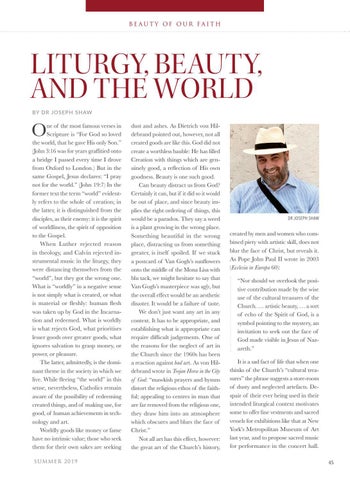BEAUT Y OF OUR FAITH
LITURGY, BEAUTY, AND THE WORLD BY DR J OS E PH S H AW
O
ne of the most famous verses in Scripture is “For God so loved the world, that he gave His only Son.” (John 3:16 was for years graffitied onto a bridge I passed every time I drove from Oxford to London.) But in the same Gospel, Jesus declares: “I pray not for the world.” (John 19:7) In the former text the term “world” evidently refers to the whole of creation; in the latter, it is distinguished from the disciples, as their enemy: it is the spirit of worldliness, the spirit of opposition to the Gospel. When Luther rejected reason in theology, and Calvin rejected instrumental music in the liturgy, they were distancing themselves from the “world”, but they got the wrong one. What is “worldly” in a negative sense is not simply what is created, or what is material or fleshly: human flesh was taken up by God in the Incarnation and redeemed. What is worldly is what rejects God, what prioritises lesser goods over greater goods, what ignores salvation to grasp money, or power, or pleasure. The latter, admittedly, is the dominant theme in the society in which we live. While fleeing “the world” in this sense, nevertheless, Catholics remain aware of the possibility of redeeming created things, and of making use, for good, of human achievements in technology and art. Worldly goods like money or fame have no intrinsic value; those who seek them for their own sakes are seeking SUM ME R 2 0 1 9
dust and ashes. As Dietrich von Hildebrand pointed out, however, not all created goods are like this. God did not create a worthless bauble: He has filled Creation with things which are genuinely good, a reflection of His own goodness. Beauty is one such good. Can beauty distract us from God? Certainly it can, but if it did so it would be out of place, and since beauty implies the right ordering of things, this would be a paradox. They say a weed is a plant growing in the wrong place. Something beautiful in the wrong place, distracting us from something greater, is itself spoiled. If we stuck a postcard of Van Gogh’s sunflowers onto the middle of the Mona Lisa with blu tack, we might hesitate to say that Van Gogh’s masterpiece was ugly, but the overall effect would be an aesthetic disaster. It would be a failure of taste. We don’t just want any art in any context. It has to be appropriate, and establishing what is appropriate can require difficult judgements. One of the reasons for the neglect of art in the Church since the 1960s has been a reaction against bad art. As von Hildebrand wrote in Trojan Horse in the City of God: “mawkish prayers and hymns distort the religious ethos of the faithful; appealing to centres in man that are far removed from the religious one, they draw him into an atmosphere which obscures and blurs the face of Christ.” Not all art has this effect, however: the great art of the Church’s history,
DR JOSEPH SHAW
created by men and women who combined piety with artistic skill, does not blur the face of Christ, but reveals it. As Pope John Paul II wrote in 2003 (Ecclesia in Europa 60): “Nor should we overlook the positive contribution made by the wise use of the cultural treasures of the Church. … artistic beauty, … a sort of echo of the Spirit of God, is a symbol pointing to the mystery, an invitation to seek out the face of God made visible in Jesus of Nazareth.” It is a sad fact of life that when one thinks of the Church’s “cultural treasures” the phrase suggests a store-room of dusty and neglected artefacts. Despair of their ever being used in their intended liturgical context motivates some to offer fine vestments and sacred vessels for exhibitions like that at New York’s Metropolitan Museum of Art last year, and to propose sacred music for performance in the concert hall. 45










